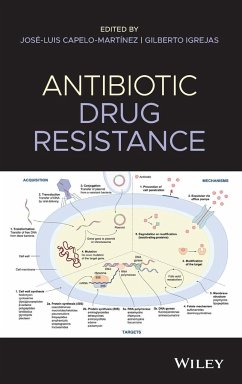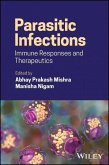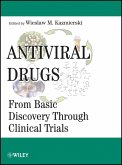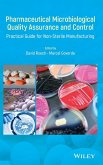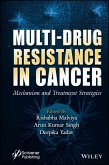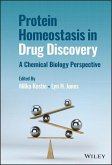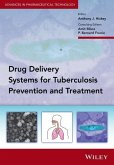Antibiotic Drug Resistance
Herausgegeben:Capelo-Martínez, José-Luis; Igrejas, Gilberto
Antibiotic Drug Resistance
Herausgegeben:Capelo-Martínez, José-Luis; Igrejas, Gilberto
- Gebundenes Buch
- Merkliste
- Auf die Merkliste
- Bewerten Bewerten
- Teilen
- Produkt teilen
- Produkterinnerung
- Produkterinnerung
This book presents a thorough and authoritative overview of the multifaceted field of antibiotic science - offering guidance to translate research into tools for prevention, diagnosis, and treatment of infectious diseases. _ Provides readers with knowledge about the broad field of drug resistance _ Offers guidance to translate research into tools for prevention, diagnosis, and treatment of infectious diseases _ Links strategies to analyze microbes to the development of new drugs, socioeconomic impacts to therapeutic strategies, and public policies to antibiotic-resistance-prevention strategies
Andere Kunden interessierten sich auch für
![Parasitic Infections Parasitic Infections]() Parasitic Infections214,99 €
Parasitic Infections214,99 €![Antiviral Drugs Antiviral Drugs]() Wieslaw M. KazmierskiAntiviral Drugs184,99 €
Wieslaw M. KazmierskiAntiviral Drugs184,99 €![Pharmaceutical Microbiological Quality Assurance and Control Pharmaceutical Microbiological Quality Assurance and Control]() Pharmaceutical Microbiological Quality Assurance and Control193,99 €
Pharmaceutical Microbiological Quality Assurance and Control193,99 €![Multi-Drug Resistance in Cancer Multi-Drug Resistance in Cancer]() Multi-Drug Resistance in Cancer192,50 €
Multi-Drug Resistance in Cancer192,50 €![Gpcrs as Therapeutic Targets Gpcrs as Therapeutic Targets]() Gpcrs as Therapeutic Targets377,99 €
Gpcrs as Therapeutic Targets377,99 €![Protein Homeostasis in Drug Discovery Protein Homeostasis in Drug Discovery]() Protein Homeostasis in Drug Discovery215,99 €
Protein Homeostasis in Drug Discovery215,99 €![Delivery Systems for Tuberculosis Prevention and Treatment Delivery Systems for Tuberculosis Prevention and Treatment]() Delivery Systems for Tuberculosis Prevention and Treatment183,99 €
Delivery Systems for Tuberculosis Prevention and Treatment183,99 €-
-
-
This book presents a thorough and authoritative overview of the multifaceted field of antibiotic science - offering guidance to translate research into tools for prevention, diagnosis, and treatment of infectious diseases.
_ Provides readers with knowledge about the broad field of drug resistance
_ Offers guidance to translate research into tools for prevention, diagnosis, and treatment of infectious diseases
_ Links strategies to analyze microbes to the development of new drugs, socioeconomic impacts to therapeutic strategies, and public policies to antibiotic-resistance-prevention strategies
Hinweis: Dieser Artikel kann nur an eine deutsche Lieferadresse ausgeliefert werden.
_ Provides readers with knowledge about the broad field of drug resistance
_ Offers guidance to translate research into tools for prevention, diagnosis, and treatment of infectious diseases
_ Links strategies to analyze microbes to the development of new drugs, socioeconomic impacts to therapeutic strategies, and public policies to antibiotic-resistance-prevention strategies
Hinweis: Dieser Artikel kann nur an eine deutsche Lieferadresse ausgeliefert werden.
Produktdetails
- Produktdetails
- Verlag: Wiley / Wiley & Sons
- Artikelnr. des Verlages: 1W119282520
- 1. Auflage
- Seitenzahl: 720
- Erscheinungstermin: 24. September 2019
- Englisch
- Abmessung: 235mm x 157mm x 43mm
- Gewicht: 1194g
- ISBN-13: 9781119282525
- ISBN-10: 1119282527
- Artikelnr.: 55913026
- Herstellerkennzeichnung
- Libri GmbH
- Europaallee 1
- 36244 Bad Hersfeld
- gpsr@libri.de
- Verlag: Wiley / Wiley & Sons
- Artikelnr. des Verlages: 1W119282520
- 1. Auflage
- Seitenzahl: 720
- Erscheinungstermin: 24. September 2019
- Englisch
- Abmessung: 235mm x 157mm x 43mm
- Gewicht: 1194g
- ISBN-13: 9781119282525
- ISBN-10: 1119282527
- Artikelnr.: 55913026
- Herstellerkennzeichnung
- Libri GmbH
- Europaallee 1
- 36244 Bad Hersfeld
- gpsr@libri.de
JOSÉ-LUIS CAPELO-MARTÍNEZ PHD, is Associate Professor in the Department of Chemistry of the Faculty of Science and Technology of the NOVA University of Lisbon. GILBERTO IGREJAS PHD, is an Associate Professor with habilitation in the Department of Genetics and Biotechnology at the University of Trás-os-Montes and Alto Douro in Portugal.
List of Contributors xix
Preface xxv
About the Editors xxvii
Part I Current Antibiotics and Their Mechanism of Action 1
1 Resistance to Aminoglycosides: Glycomics and the Link to the Human Gut Microbiome 3
Viviana G. Correia, Benedita A. Pinheiro, Ana Luísa Carvalho, and Angelina S. Palma
1.1 Aminoglycosides as Antimicrobial Drugs 3
1.1.1 The Structure of Aminoglycosides 5
1.1.2 Mechanisms of Action 8
1.2 Mechanisms of Resistance 10
1.2.1 Aminoglycoside-Modifying Enzymes 10
1.2.2 Mutation or Modification of Ribosomal Target Sequences 13
1.2.3 Changes in Uptake and Efflux 14
1.3 Development of New AGAs: The Potential of Glycomics 16
1.3.1 Exploitation of Carbohydrate Chemistry to Study Structure-Activity Relationship of Aminoglycoside Derivatives 17
1.3.2 Aminoglycoside Microarrays to Screen Interactions of Antibiotics with RNAs and Proteins 18
1.4 Influence of the Human Microbiome in Aminoglycoside Resistance 20
1.4.1 The Effect of Antibiotic-Induced Alterations 21
1.4.2 A Reservoir of Antibiotic Resistance 24
1.4.3 Strategies to Modulate the Human Microbiome 25
1.5 Conclusions and Outlook 26
Acknowledgments 27
References 28
2 Mechanisms of Action and of Resistance to Quinolones 39
José L. Martínez
2.1 Introduction 39
2.2 Mechanism of Action of Quinolones 40
2.3 Mutations in the Genes Encoding the Targets of Quinolones 41
2.4 Multidrug Efflux Pumps and Quinolone Resistance 42
2.5 Transferable Quinolone Resistance 43
2.6 Stenotrophomonas maltophilia and Its Uncommon Mechanisms of Resistance to Quinolones 46
Acknowledgments 47
References 47
3 Beta-Lactams 57
Luz Balsalobre, Ana Blanco, and Teresa Alarcón
3.1 Introduction 57
3.2 Chemical Structure 58
3.3 Classification and Spectrum of Activity 59
3.3.1 Penicillins 59
3.3.2 Cephalosporins 61
3.3.3 Monobactams 63
3.3.4 Carbapenems 64
3.3.5 Beta-Lactam Associated with Beta-Lactamase Inhibitors 64
3.4 Mechanism of Action 66
3.5 Activity of Beta-Lactams Against Multiresistant Bacteria 68
3.6 Conclusions 70
References 70
4 Glycopeptide Antibiotics: Mechanism of Action and Recent Developments 73
Paramita Sarkar and Jayanta Haldar
4.1 Introduction 73
4.2 Naturally Occurring Glycopeptide Antibiotics 75
4.3 Mechanism of Action of Glycopeptide Antibiotics 76
4.4 Resistance to Glycopeptides 78
4.5 Second-Generation Glycopeptides 79
4.5.1 Telavancin 79
4.5.2 Dalbavancin 80
4.5.3 Oritavancin 80
4.6 Strategies to Overcome Resistance to Glycopeptides 81
4.6.1 Modifications That Enhance the Binding Affinity to Target Pentapeptide 81
4.6.2 Incorporation of Lipophilicity 85
4.6.3 Incorporation of Lipophilic Cationic Moieties to Impart Membrane Disruption Properties 86
4.6.4 Incorporation of Metal Chelating Moiety to Vancomycin to Impart New Mechanism of Action 88
4.7 Glycopeptides Under Clinical Trials 88
4.8 Glycopeptide Antibiotics: The Challenges 90
References 91
5 Current Macrolide Antibiotics and Their Mechanisms of Action 97
S. Lohsen and D.S. Stephens
5.1 Introduction 97
5.2 Structure of Macrolides 99
5.3 Macrolide Mechanisms of Action 101
5.4 Clinical Use of Macrolides 104
5.5 Next-Generation Macrolides and Future Use 107
Preface xxv
About the Editors xxvii
Part I Current Antibiotics and Their Mechanism of Action 1
1 Resistance to Aminoglycosides: Glycomics and the Link to the Human Gut Microbiome 3
Viviana G. Correia, Benedita A. Pinheiro, Ana Luísa Carvalho, and Angelina S. Palma
1.1 Aminoglycosides as Antimicrobial Drugs 3
1.1.1 The Structure of Aminoglycosides 5
1.1.2 Mechanisms of Action 8
1.2 Mechanisms of Resistance 10
1.2.1 Aminoglycoside-Modifying Enzymes 10
1.2.2 Mutation or Modification of Ribosomal Target Sequences 13
1.2.3 Changes in Uptake and Efflux 14
1.3 Development of New AGAs: The Potential of Glycomics 16
1.3.1 Exploitation of Carbohydrate Chemistry to Study Structure-Activity Relationship of Aminoglycoside Derivatives 17
1.3.2 Aminoglycoside Microarrays to Screen Interactions of Antibiotics with RNAs and Proteins 18
1.4 Influence of the Human Microbiome in Aminoglycoside Resistance 20
1.4.1 The Effect of Antibiotic-Induced Alterations 21
1.4.2 A Reservoir of Antibiotic Resistance 24
1.4.3 Strategies to Modulate the Human Microbiome 25
1.5 Conclusions and Outlook 26
Acknowledgments 27
References 28
2 Mechanisms of Action and of Resistance to Quinolones 39
José L. Martínez
2.1 Introduction 39
2.2 Mechanism of Action of Quinolones 40
2.3 Mutations in the Genes Encoding the Targets of Quinolones 41
2.4 Multidrug Efflux Pumps and Quinolone Resistance 42
2.5 Transferable Quinolone Resistance 43
2.6 Stenotrophomonas maltophilia and Its Uncommon Mechanisms of Resistance to Quinolones 46
Acknowledgments 47
References 47
3 Beta-Lactams 57
Luz Balsalobre, Ana Blanco, and Teresa Alarcón
3.1 Introduction 57
3.2 Chemical Structure 58
3.3 Classification and Spectrum of Activity 59
3.3.1 Penicillins 59
3.3.2 Cephalosporins 61
3.3.3 Monobactams 63
3.3.4 Carbapenems 64
3.3.5 Beta-Lactam Associated with Beta-Lactamase Inhibitors 64
3.4 Mechanism of Action 66
3.5 Activity of Beta-Lactams Against Multiresistant Bacteria 68
3.6 Conclusions 70
References 70
4 Glycopeptide Antibiotics: Mechanism of Action and Recent Developments 73
Paramita Sarkar and Jayanta Haldar
4.1 Introduction 73
4.2 Naturally Occurring Glycopeptide Antibiotics 75
4.3 Mechanism of Action of Glycopeptide Antibiotics 76
4.4 Resistance to Glycopeptides 78
4.5 Second-Generation Glycopeptides 79
4.5.1 Telavancin 79
4.5.2 Dalbavancin 80
4.5.3 Oritavancin 80
4.6 Strategies to Overcome Resistance to Glycopeptides 81
4.6.1 Modifications That Enhance the Binding Affinity to Target Pentapeptide 81
4.6.2 Incorporation of Lipophilicity 85
4.6.3 Incorporation of Lipophilic Cationic Moieties to Impart Membrane Disruption Properties 86
4.6.4 Incorporation of Metal Chelating Moiety to Vancomycin to Impart New Mechanism of Action 88
4.7 Glycopeptides Under Clinical Trials 88
4.8 Glycopeptide Antibiotics: The Challenges 90
References 91
5 Current Macrolide Antibiotics and Their Mechanisms of Action 97
S. Lohsen and D.S. Stephens
5.1 Introduction 97
5.2 Structure of Macrolides 99
5.3 Macrolide Mechanisms of Action 101
5.4 Clinical Use of Macrolides 104
5.5 Next-Generation Macrolides and Future Use 107
List of Contributors xix
Preface xxv
About the Editors xxvii
Part I Current Antibiotics and Their Mechanism of Action 1
1 Resistance to Aminoglycosides: Glycomics and the Link to the Human Gut Microbiome 3
Viviana G. Correia, Benedita A. Pinheiro, Ana Luísa Carvalho, and Angelina S. Palma
1.1 Aminoglycosides as Antimicrobial Drugs 3
1.1.1 The Structure of Aminoglycosides 5
1.1.2 Mechanisms of Action 8
1.2 Mechanisms of Resistance 10
1.2.1 Aminoglycoside-Modifying Enzymes 10
1.2.2 Mutation or Modification of Ribosomal Target Sequences 13
1.2.3 Changes in Uptake and Efflux 14
1.3 Development of New AGAs: The Potential of Glycomics 16
1.3.1 Exploitation of Carbohydrate Chemistry to Study Structure-Activity Relationship of Aminoglycoside Derivatives 17
1.3.2 Aminoglycoside Microarrays to Screen Interactions of Antibiotics with RNAs and Proteins 18
1.4 Influence of the Human Microbiome in Aminoglycoside Resistance 20
1.4.1 The Effect of Antibiotic-Induced Alterations 21
1.4.2 A Reservoir of Antibiotic Resistance 24
1.4.3 Strategies to Modulate the Human Microbiome 25
1.5 Conclusions and Outlook 26
Acknowledgments 27
References 28
2 Mechanisms of Action and of Resistance to Quinolones 39
José L. Martínez
2.1 Introduction 39
2.2 Mechanism of Action of Quinolones 40
2.3 Mutations in the Genes Encoding the Targets of Quinolones 41
2.4 Multidrug Efflux Pumps and Quinolone Resistance 42
2.5 Transferable Quinolone Resistance 43
2.6 Stenotrophomonas maltophilia and Its Uncommon Mechanisms of Resistance to Quinolones 46
Acknowledgments 47
References 47
3 Beta-Lactams 57
Luz Balsalobre, Ana Blanco, and Teresa Alarcón
3.1 Introduction 57
3.2 Chemical Structure 58
3.3 Classification and Spectrum of Activity 59
3.3.1 Penicillins 59
3.3.2 Cephalosporins 61
3.3.3 Monobactams 63
3.3.4 Carbapenems 64
3.3.5 Beta-Lactam Associated with Beta-Lactamase Inhibitors 64
3.4 Mechanism of Action 66
3.5 Activity of Beta-Lactams Against Multiresistant Bacteria 68
3.6 Conclusions 70
References 70
4 Glycopeptide Antibiotics: Mechanism of Action and Recent Developments 73
Paramita Sarkar and Jayanta Haldar
4.1 Introduction 73
4.2 Naturally Occurring Glycopeptide Antibiotics 75
4.3 Mechanism of Action of Glycopeptide Antibiotics 76
4.4 Resistance to Glycopeptides 78
4.5 Second-Generation Glycopeptides 79
4.5.1 Telavancin 79
4.5.2 Dalbavancin 80
4.5.3 Oritavancin 80
4.6 Strategies to Overcome Resistance to Glycopeptides 81
4.6.1 Modifications That Enhance the Binding Affinity to Target Pentapeptide 81
4.6.2 Incorporation of Lipophilicity 85
4.6.3 Incorporation of Lipophilic Cationic Moieties to Impart Membrane Disruption Properties 86
4.6.4 Incorporation of Metal Chelating Moiety to Vancomycin to Impart New Mechanism of Action 88
4.7 Glycopeptides Under Clinical Trials 88
4.8 Glycopeptide Antibiotics: The Challenges 90
References 91
5 Current Macrolide Antibiotics and Their Mechanisms of Action 97
S. Lohsen and D.S. Stephens
5.1 Introduction 97
5.2 Structure of Macrolides 99
5.3 Macrolide Mechanisms of Action 101
5.4 Clinical Use of Macrolides 104
5.5 Next-Generation Macrolides and Future Use 107
Preface xxv
About the Editors xxvii
Part I Current Antibiotics and Their Mechanism of Action 1
1 Resistance to Aminoglycosides: Glycomics and the Link to the Human Gut Microbiome 3
Viviana G. Correia, Benedita A. Pinheiro, Ana Luísa Carvalho, and Angelina S. Palma
1.1 Aminoglycosides as Antimicrobial Drugs 3
1.1.1 The Structure of Aminoglycosides 5
1.1.2 Mechanisms of Action 8
1.2 Mechanisms of Resistance 10
1.2.1 Aminoglycoside-Modifying Enzymes 10
1.2.2 Mutation or Modification of Ribosomal Target Sequences 13
1.2.3 Changes in Uptake and Efflux 14
1.3 Development of New AGAs: The Potential of Glycomics 16
1.3.1 Exploitation of Carbohydrate Chemistry to Study Structure-Activity Relationship of Aminoglycoside Derivatives 17
1.3.2 Aminoglycoside Microarrays to Screen Interactions of Antibiotics with RNAs and Proteins 18
1.4 Influence of the Human Microbiome in Aminoglycoside Resistance 20
1.4.1 The Effect of Antibiotic-Induced Alterations 21
1.4.2 A Reservoir of Antibiotic Resistance 24
1.4.3 Strategies to Modulate the Human Microbiome 25
1.5 Conclusions and Outlook 26
Acknowledgments 27
References 28
2 Mechanisms of Action and of Resistance to Quinolones 39
José L. Martínez
2.1 Introduction 39
2.2 Mechanism of Action of Quinolones 40
2.3 Mutations in the Genes Encoding the Targets of Quinolones 41
2.4 Multidrug Efflux Pumps and Quinolone Resistance 42
2.5 Transferable Quinolone Resistance 43
2.6 Stenotrophomonas maltophilia and Its Uncommon Mechanisms of Resistance to Quinolones 46
Acknowledgments 47
References 47
3 Beta-Lactams 57
Luz Balsalobre, Ana Blanco, and Teresa Alarcón
3.1 Introduction 57
3.2 Chemical Structure 58
3.3 Classification and Spectrum of Activity 59
3.3.1 Penicillins 59
3.3.2 Cephalosporins 61
3.3.3 Monobactams 63
3.3.4 Carbapenems 64
3.3.5 Beta-Lactam Associated with Beta-Lactamase Inhibitors 64
3.4 Mechanism of Action 66
3.5 Activity of Beta-Lactams Against Multiresistant Bacteria 68
3.6 Conclusions 70
References 70
4 Glycopeptide Antibiotics: Mechanism of Action and Recent Developments 73
Paramita Sarkar and Jayanta Haldar
4.1 Introduction 73
4.2 Naturally Occurring Glycopeptide Antibiotics 75
4.3 Mechanism of Action of Glycopeptide Antibiotics 76
4.4 Resistance to Glycopeptides 78
4.5 Second-Generation Glycopeptides 79
4.5.1 Telavancin 79
4.5.2 Dalbavancin 80
4.5.3 Oritavancin 80
4.6 Strategies to Overcome Resistance to Glycopeptides 81
4.6.1 Modifications That Enhance the Binding Affinity to Target Pentapeptide 81
4.6.2 Incorporation of Lipophilicity 85
4.6.3 Incorporation of Lipophilic Cationic Moieties to Impart Membrane Disruption Properties 86
4.6.4 Incorporation of Metal Chelating Moiety to Vancomycin to Impart New Mechanism of Action 88
4.7 Glycopeptides Under Clinical Trials 88
4.8 Glycopeptide Antibiotics: The Challenges 90
References 91
5 Current Macrolide Antibiotics and Their Mechanisms of Action 97
S. Lohsen and D.S. Stephens
5.1 Introduction 97
5.2 Structure of Macrolides 99
5.3 Macrolide Mechanisms of Action 101
5.4 Clinical Use of Macrolides 104
5.5 Next-Generation Macrolides and Future Use 107

